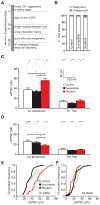Stress and Cocaine Trigger Divergent and Cell Type-Specific Regulation of Synaptic Transmission at Single Spines in Nucleus Accumbens
- PMID: 26164802
- PMCID: PMC4670821
- DOI: 10.1016/j.biopsych.2015.05.022
Stress and Cocaine Trigger Divergent and Cell Type-Specific Regulation of Synaptic Transmission at Single Spines in Nucleus Accumbens
Abstract
Background: Repeated exposure to cocaine or social stress leads to lasting structural and functional synaptic alterations in medium spiny neurons (MSNs) of nucleus accumbens (NAc). Although cocaine-induced and stress-induced structural changes in dendritic spines have been well documented, few studies have investigated functional consequences of cocaine and stress at the level of single spines.
Methods: We exposed mice to chronic cocaine or chronic social defeat stress and used two-photon laser scanning microscopy with glutamate photo-uncaging and whole-cell recording to examine synaptic strength at individual spines on two distinct types of NAc MSNs in acute slices after 24 hours of cocaine withdrawal and after chronic social defeat stress.
Results: In animals treated with cocaine, average synaptic strength was reduced specifically at large mushroom spines of MSNs expressing dopamine receptor type 1 (D1-MSNs). In contrast, cocaine promoted a rightward shift in the distribution of synaptic weights toward larger synaptic responses in MSNs expressing dopamine receptor type 2 (D2-MSNs). After chronic social defeat stress, resilient animals displayed an upregulation of synaptic strength at large mushroom spines of D1-MSNs and a concomitant downregulation in D2-MSNs. Although susceptible mice did not exhibit a significant overall change in synaptic strength on D1-MSNs or D2-MSNs, we observed a slight leftward shift in cumulative distribution of large synaptic responses in both cell types.
Conclusions: This study provides the first functional cell type-specific and spine type-specific comparison of synaptic strength at a single spine level between cocaine-induced and stress-induced neuroadaptations and demonstrates that psychoactive drugs and stress trigger divergent changes in synaptic function in NAc.
Keywords: Chronic social defeat stress; Cocaine addiction; Dendritic spine; Glutamate uncaging; Nucleus accumbens; Synaptic transmission.
Copyright © 2016 Society of Biological Psychiatry. Published by Elsevier Inc. All rights reserved.
Figures



Comment in
-
A NAc for Spinal Adjustments After Cocaine or Stress.Biol Psychiatry. 2016 Jun 1;79(11):872-4. doi: 10.1016/j.biopsych.2016.04.013. Biol Psychiatry. 2016. PMID: 27198520 Free PMC article. No abstract available.
Similar articles
-
∆FosB differentially modulates nucleus accumbens direct and indirect pathway function.Proc Natl Acad Sci U S A. 2013 Jan 29;110(5):1923-8. doi: 10.1073/pnas.1221742110. Epub 2013 Jan 14. Proc Natl Acad Sci U S A. 2013. PMID: 23319622 Free PMC article.
-
Nucleus accumbens medium spiny neuron subtypes mediate depression-related outcomes to social defeat stress.Biol Psychiatry. 2015 Feb 1;77(3):212-222. doi: 10.1016/j.biopsych.2014.07.021. Epub 2014 Jul 28. Biol Psychiatry. 2015. PMID: 25173629 Free PMC article.
-
Cell type-specific alterations in the nucleus accumbens by repeated exposures to cocaine.Biol Psychiatry. 2011 Jun 1;69(11):1026-34. doi: 10.1016/j.biopsych.2011.01.013. Epub 2011 Mar 5. Biol Psychiatry. 2011. PMID: 21377654
-
Differential striatal spine pathology in Parkinson's disease and cocaine addiction: a key role of dopamine?Neuroscience. 2013 Oct 22;251:2-20. doi: 10.1016/j.neuroscience.2013.07.011. Epub 2013 Jul 16. Neuroscience. 2013. PMID: 23867772 Free PMC article. Review.
-
Emerging Role for Nucleus Accumbens Medium Spiny Neuron Subtypes in Depression.Biol Psychiatry. 2017 Apr 15;81(8):645-653. doi: 10.1016/j.biopsych.2016.09.007. Epub 2016 Sep 15. Biol Psychiatry. 2017. PMID: 27871668 Free PMC article. Review.
Cited by
-
Dendritic spine density is increased on nucleus accumbens D2 neurons after chronic social defeat.Sci Rep. 2020 Jul 24;10(1):12393. doi: 10.1038/s41598-020-69339-7. Sci Rep. 2020. PMID: 32709968 Free PMC article.
-
The Selective RhoA Inhibitor Rhosin Promotes Stress Resiliency Through Enhancing D1-Medium Spiny Neuron Plasticity and Reducing Hyperexcitability.Biol Psychiatry. 2019 Jun 15;85(12):1001-1010. doi: 10.1016/j.biopsych.2019.02.007. Epub 2019 Feb 13. Biol Psychiatry. 2019. PMID: 30955841 Free PMC article.
-
Convergence of Reinforcing and Anhedonic Cocaine Effects in the Ventral Pallidum.Neuron. 2016 Oct 5;92(1):214-226. doi: 10.1016/j.neuron.2016.09.001. Epub 2016 Sep 22. Neuron. 2016. PMID: 27667004 Free PMC article.
-
Cocaine Experience Enhances Thalamo-Accumbens N-Methyl-D-Aspartate Receptor Function.Biol Psychiatry. 2016 Nov 1;80(9):671-681. doi: 10.1016/j.biopsych.2016.04.002. Epub 2016 Apr 7. Biol Psychiatry. 2016. PMID: 27209241 Free PMC article.
-
Unraveling the mysteries of dendritic spine dynamics: Five key principles shaping memory and cognition.Proc Jpn Acad Ser B Phys Biol Sci. 2023;99(8):254-305. doi: 10.2183/pjab.99.018. Proc Jpn Acad Ser B Phys Biol Sci. 2023. PMID: 37821392 Free PMC article.
References
-
- Kalivas PW. The glutamate homeostasis hypothesis of addiction. Nat Rev Neurosci. 2009;10:561–72. - PubMed
MeSH terms
Substances
Grants and funding
LinkOut - more resources
Full Text Sources
Other Literature Sources
Medical
Molecular Biology Databases

